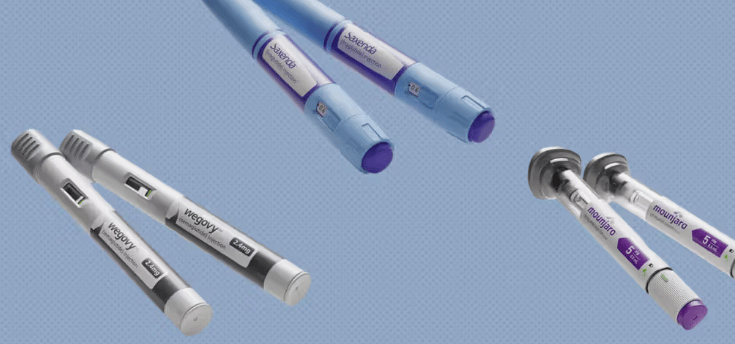Understanding GLP-1 Injections: Benefits, Downsides, and Market Variations
You see and hear the commercials everywhere and it's the latest fad with celebrities as they look overly skinny; but what exactly are GLP-1 shots? Kelly Lira takes us through what they are and is it worth a try for people that are considering these treatments.
Kelly Lira
3/19/20255 min read


What are GLP-1 Injections?
GLP-1 injections are a form of treatment that utilizes synthetic versions of the hormone Glucagon-Like Peptide-1 (GLP-1), which plays a critical role in glucose metabolism and appetite regulation. GLP-1 is naturally produced in the intestines in response to food intake, and it enhances insulin secretion while simultaneously inhibiting glucagon release. This results in better control of blood glucose levels, particularly important for individuals with type 2 diabetes. Additionally, GLP-1 acts on the brain to promote satiety, thereby aiding in weight management.
The advent of GLP-1 injections has provided an innovative therapeutic approach for patients dealing with obesity and type 2 diabetes. By mimicking the naturally occurring GLP-1, these injections help improve glucose homeostasis and reduce the risk of complications associated with diabetes. Clinical trials have demonstrated that GLP-1 receptor agonists can lead to significant weight loss and improvements in glycemic control, making them popular options for healthcare providers.
GLP-1 injections are typically administered subcutaneously, meaning they are injected just under the skin. This method allows for steady absorption and prolonged action of the medication. Common administration schedules include once weekly or daily injections, depending on the specific formulation utilized. This flexibility in dosing aids in adherence to treatment regimens among patients.
Target patient populations include those with type 2 diabetes who require additional glycemic control or are struggling with obesity. While GLP-1 injections offer significant benefits, it is crucial for patients to consult with healthcare professionals to assess their suitability for this treatment option, as individual responses may vary. In summary, GLP-1 injections represent a promising therapeutic advancement, focusing on improving metabolic health and addressing obesity-related challenges.
Health Benefits of GLP-1 Injections
GLP-1 injections have emerged as a significant therapeutic option for individuals struggling with weight management and glycemic control, particularly among those diagnosed with type 2 diabetes. One of the most notable health benefits of these injections is their role in promoting weight loss. Clinical studies have shown that patients using GLP-1 receptor agonists experience a reduction in body weight, which can be attributed to various mechanisms. These include enhanced satiety and reduced appetite, leading to decreased caloric intake over time. This aspect makes GLP-1 injections not only a viable option for diabetes management but also an attractive solution for patients seeking to improve their overall health through weight loss.
Improved glycemic control is another critical benefit of GLP-1 injections. They work by stimulating insulin secretion in response to elevated blood glucose levels while simultaneously suppressing glucagon release, a hormone that raises blood sugar. This dual action helps to lower blood glucose levels effectively, contributing to better management of diabetes. Clinical trials have confirmed that patients who incorporate GLP-1 injections into their treatment regimens achieve better hemoglobin A1c levels compared to those on traditional therapies alone.
In addition to weight loss and glycemic control, emerging evidence suggests potential cardiovascular benefits associated with GLP-1 injections. Research indicates that these medications may reduce the risk of cardiovascular events, such as heart attacks and strokes, particularly in individuals with existing cardiovascular conditions. This is attributed to various factors, including an improvement in lipid profiles and reduction in blood pressure.
The comprehensive benefits of GLP-1 injections highlight their multifaceted impact on health, making them a compelling option for individuals seeking to manage diabetes while also addressing weight-related concerns and cardiovascular risks. These positive outcomes underscore the importance of considering GLP-1 injections in the broader context of diabetes care and overall health improvement strategies.
Downsides and Considerations
While GLP-1 injections offer numerous benefits in managing conditions such as type 2 diabetes and obesity, it is crucial to consider the potential downsides associated with their use. A variety of gastrointestinal side effects, including nausea, vomiting, diarrhea, and abdominal pain, are commonly reported among patients. These symptoms often arise due to the way GLP-1 mimetics slow gastric emptying, which can lead to discomfort, particularly during the initial stages of treatment. Most patients find that these side effects diminish over time, but they remain an important consideration for anyone contemplating GLP-1 therapy.
There is also a notable risk of pancreatitis associated with GLP-1 injections. Though rare, acute pancreatitis can occur, leading to severe abdominal pain and hospitalization. Patients with a history of pancreatitis should approach GLP-1 treatment with caution, discussing their medical history with healthcare providers. It is critical to weigh the risks versus the benefits of initiating treatment, especially for those who may be predisposed to pancreatic issues.
Injection site reactions are another consideration, as some patients may experience local irritation, swelling, or redness at the site of administration. These reactions are typically mild and may resolve on their own, but any persistent issues should be evaluated by a medical professional. Furthermore, specific populations, such as those with a personal or family history of medullary thyroid carcinoma or multiple endocrine neoplasia syndrome type 2, may require careful assessment before starting GLP-1 therapy due to potential contraindications.
Before starting GLP-1 injections, consulting with healthcare professionals is essential. They can provide a comprehensive evaluation of the patient's overall health and help identify potential risks and appropriate monitoring strategies throughout the treatment process. It is vital for patients to remain informed about the potential downsides and make a well-considered decision regarding their treatment options.
Exploring Variations in the Market
In recent years, the market for GLP-1 (glucagon-like peptide-1) injection medications has grown significantly, showcasing a variety of options for individuals requiring effective management of type 2 diabetes and weight loss. Key players in this sector include established pharmaceutical companies such as Novo Nordisk, Eli Lilly, and Sanofi, each offering distinct formulations of GLP-1 medications that cater to different patient needs.
Among the most prominent GLP-1 injections are Semaglutide, Liraglutide, and Dulaglutide. Semaglutide, marketed under the brand names Ozempic and Wegovy, demonstrates strong efficacy in both glycemic control and weight management. Liraglutide, known as Victoza for diabetes treatment and Saxenda for weight loss, presents similar benefits but comes with variations in dosing schedules. Dulaglutide, marketed as Trulicity, is another popular choice, characterized by its once-weekly administration, which offers convenience for patients.
The dosing schedules of these medications vary, with some requiring daily administration, while others allow for weekly injections. This flexibility can play a significant role in a patient's adherence to the treatment regimen. Efficacy, too, is a crucial factor which can sway patient decisions; in clinical trials, medications such as Semaglutide have shown superior weight loss outcomes compared to some peers.
Cost considerations also greatly influence the choice of GLP-1 medications. The price of these injections can differ based on the formulation, manufacturer, and insurance coverage, leaving patients to weigh the financial implications of their treatment options.
Ultimately, the decision regarding which GLP-1 injection to utilize should take into account individual health profiles, preferences, and lifestyle factors. Personalized discussions between healthcare providers and patients are essential to determine the most appropriate GLP-1 medication, ensuring optimal management of diabetes and weight-related challenges.
Why Consider GLP-1 Injections?
GLP-1 injections have garnered significant attention in the realm of diabetes management and weight control, primarily due to their multifaceted benefits. These injectable medications, which mimic the effects of the glucagon-like peptide-1 hormone, are designed to enhance glycemic control in individuals with type 2 diabetes while promoting weight loss, which is a critical factor for obtaining better health outcomes.
One of the primary reasons individuals might opt for GLP-1 injections is their efficacy in controlling blood sugar levels. For patients whose traditional oral medications have failed to manage blood glucose effectively, GLP-1 injections offer an alternative by stimulating insulin secretion in response to elevated glucose levels. This mechanism not only aids in maintaining more stable blood sugar but also reduces the risk of complications associated with poorly managed diabetes.
Weight loss is another compelling reason to consider these injections. Research indicates that GLP-1 therapy can lead to significant reductions in body weight, making it a valuable option for individuals struggling with obesity or excess weight, particularly those with associated metabolic concerns. This weight loss is achieved through appetite regulation, which helps patients make healthier food choices while also promoting feelings of satiety during meals.
Nonetheless, it is crucial to acknowledge the downsides associated with GLP-1 injections, such as potential side effects and the need for ongoing medical supervision. Given these factors, individuals contemplating this therapy should engage in discussions with their healthcare providers to assess their specific circumstances. Personalized medical advice will ensure that potential benefits are weighed against the risks effectively. In conclusion, for those struggling with weight management or type 2 diabetes, GLP-1 injections can be a beneficial treatment option, provided they are considered carefully and administered under professional guidance.
Connect
Join us for health and wealth insights today!
Inspire
Thrive
gigscares@gigshealth.com
© 2025. All rights reserved.
